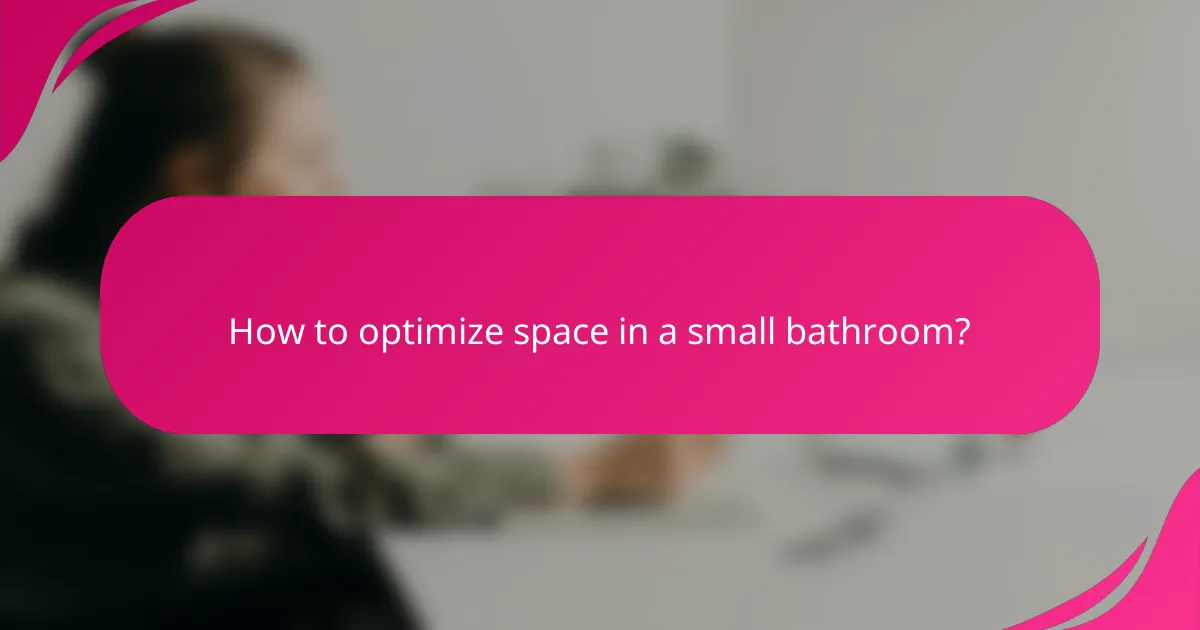Transforming your bathroom into a spa-like retreat involves careful attention to design elements that foster relaxation and serenity. By selecting modern fixtures that enhance functionality and conserve water, you can elevate the space while maintaining a tranquil atmosphere. Additionally, optimizing space through smart storage solutions and compact designs will ensure that even the smallest bathrooms feel open and inviting.

How to create a spa-like atmosphere in your bathroom?
To create a spa-like atmosphere in your bathroom, focus on incorporating elements that promote relaxation and tranquility. This includes using natural materials, calming colors, and thoughtful lighting to enhance the overall experience.
Incorporate natural materials
Using natural materials like wood, stone, and bamboo can significantly enhance the spa-like feel of your bathroom. Consider wooden vanities, stone countertops, or bamboo accents to create warmth and connection to nature.
Choose materials that are durable and water-resistant, such as teak or cedar, which can withstand the humid environment of a bathroom. This not only adds aesthetic value but also ensures longevity.
Use calming color palettes
Calming color palettes are essential for a serene bathroom atmosphere. Soft hues like light blues, greens, and neutral tones can evoke a sense of peace and relaxation.
Consider painting the walls in these soothing colors or using tiles in similar shades. Accessories like towels and rugs can also follow this color scheme to maintain a cohesive look.
Add ambient lighting
Ambient lighting is crucial for creating a relaxing environment. Use dimmable lights or fixtures that allow for adjustable brightness to set the mood according to your needs.
Incorporate soft, warm LED lights in key areas, such as around mirrors or in shower niches, to enhance the calming effect. Avoid harsh fluorescent lighting, which can be jarring and uninviting.
Install a soaking tub
A soaking tub can be a centerpiece in your spa-like bathroom, offering a luxurious way to unwind. Look for deep tubs that allow for full immersion and relaxation.
Consider freestanding models for a modern touch or built-in options that blend seamlessly with your design. Adding features like jets or heated surfaces can further enhance the experience.
Include plants for freshness
Incorporating plants can bring life and freshness to your bathroom. Choose moisture-loving varieties such as ferns, peace lilies, or spider plants that thrive in humid environments.
Position plants on windowsills or shelves to maximize natural light and improve air quality. They not only enhance aesthetics but also contribute to a calming atmosphere.

What are the best fixtures for a modern bathroom?
The best fixtures for a modern bathroom enhance functionality, conserve water, and contribute to a spa-like atmosphere. Key options include high-efficiency faucets, smart toilets, rain showerheads, and touchless controls, each offering unique benefits for a contemporary space.
High-efficiency faucets
High-efficiency faucets are designed to reduce water consumption without sacrificing performance. Look for models that use less than 1.5 gallons per minute, which can significantly lower your water bill while maintaining a strong flow.
When selecting a faucet, consider features like aerators that mix air with water to create a fuller spray. This not only conserves water but also enhances the overall experience, making it feel luxurious.
Smart toilets
Smart toilets offer advanced features such as automatic flushing, heated seats, and built-in bidets. These toilets can improve hygiene and comfort, making them a popular choice for modern bathrooms.
When choosing a smart toilet, consider the power source and whether it requires a dedicated outlet. Models with dual-flush options can also help save water, using less for liquid waste and more for solid waste.
Rain showerheads
Rain showerheads provide a relaxing, spa-like experience by mimicking the sensation of rainfall. They typically have a larger surface area and lower flow rates, often around 2.5 gallons per minute, which creates a gentle and soothing shower.
Installation height is crucial for maximizing the rain shower experience. Ensure the showerhead is positioned at a comfortable height to allow for full coverage without excessive splashing.
Touchless controls
Touchless controls for faucets and toilets enhance convenience and hygiene by allowing users to operate fixtures without physical contact. This feature is especially beneficial in preventing the spread of germs in the bathroom.
When installing touchless fixtures, consider the power source, as some models may require batteries or a nearby electrical outlet. Ensure the sensors are positioned correctly to avoid accidental activation and ensure smooth operation.

How to optimize space in a small bathroom?
To optimize space in a small bathroom, focus on maximizing functionality while minimizing clutter. This can be achieved through strategic storage solutions, selecting compact fixtures, and utilizing design elements that create an illusion of space.
Use wall-mounted storage
Wall-mounted storage is an effective way to free up floor space in a small bathroom. Shelves, cabinets, and hooks can be installed above sinks or toilets, allowing you to keep essential items within reach while maintaining an open floor area.
Consider using floating shelves or cabinets that blend with the wall color to create a seamless look. This not only saves space but also enhances the aesthetic appeal of the bathroom.
Choose compact fixtures
Opting for compact fixtures is crucial in a small bathroom. Look for smaller vanities, toilets, and bathtubs that fit your space without sacrificing comfort or usability. For instance, a corner sink can save valuable space while still providing functionality.
When selecting fixtures, check dimensions carefully and prioritize models designed specifically for smaller areas. This can help you avoid overcrowding and ensure a more comfortable experience.
Incorporate mirrors for depth
Mirrors can significantly enhance the perception of space in a small bathroom. A large mirror or multiple smaller mirrors can reflect light and create an illusion of depth, making the room feel larger and more open.
Position mirrors opposite windows or light sources to maximize natural light reflection. Additionally, consider mirrored cabinets that combine storage with the benefits of reflective surfaces.
Utilize vertical space
Utilizing vertical space is essential for optimizing a small bathroom. Tall cabinets or shelving units can store items without taking up much floor space, allowing you to keep essentials organized and accessible.
Install hooks or racks on the back of the door or on walls to hang towels and robes. This not only saves space but also adds to the overall functionality of the bathroom.

What are the costs associated with bathroom renovation?
The costs associated with bathroom renovation can vary widely based on factors such as size, materials, and labor. Generally, homeowners should expect to invest a few thousand to tens of thousands of dollars for a complete remodel, depending on the desired upgrades and finishes.
Average cost per square foot
The average cost per square foot for a bathroom renovation typically ranges from $100 to $300. This figure can fluctuate based on the complexity of the project, the quality of materials selected, and the geographical location of the home.
For instance, a basic remodel might cost around $100 per square foot, while a high-end renovation with luxury fixtures could reach $300 or more. It’s essential to assess your specific needs and budget to determine the appropriate investment.
Cost breakdown by fixture type
When renovating a bathroom, costs can be broken down by fixture type, including sinks, toilets, showers, and bathtubs. On average, a new toilet can cost between $200 and $500, while sinks may range from $150 to $1,000 depending on the style and material.
Showers and bathtubs can significantly impact the budget, with basic models starting around $500 and luxury options exceeding $3,000. Prioritizing which fixtures to upgrade can help manage overall costs effectively.
Budgeting for labor and materials
Labor costs typically account for 20% to 35% of the total renovation budget. Hiring skilled professionals for plumbing, electrical work, and installation is crucial for ensuring quality and compliance with local building codes.
Materials can vary widely in price, so it’s wise to create a detailed list of necessary items and research options. Consider allocating funds for unexpected expenses, as renovations often uncover hidden issues that require additional investment.

What are the latest trends in bathroom design?
The latest trends in bathroom design focus on creating a spa-like atmosphere, enhancing fixtures, and optimizing space. Homeowners are increasingly prioritizing comfort and functionality, integrating modern technologies and sustainable materials into their renovations.
Creating a spa-like atmosphere
To achieve a spa-like atmosphere in your bathroom, consider incorporating natural materials, soft lighting, and calming colors. Elements such as large soaking tubs, rainfall showerheads, and heated floors can enhance relaxation and comfort.
Adding plants or natural decor can further promote tranquility. Use neutral tones and textures to create a serene environment, and consider soundproofing to minimize noise from outside.
Improved fixtures
Upgrading fixtures is essential for modern bathroom design. Look for water-efficient faucets and showerheads that not only save water but also provide a luxurious experience. Smart technology, such as touchless faucets and programmable showers, can enhance convenience.
Choose durable materials like brushed nickel or matte black finishes for a contemporary look. Ensure that fixtures are easy to maintain and complement the overall design theme of your bathroom.
Space optimization
Space optimization is crucial, especially in smaller bathrooms. Consider using wall-mounted vanities and shelves to free up floor space. Sliding doors can also save room compared to traditional swinging doors.
Incorporate multifunctional furniture, such as a bench that doubles as storage. Use mirrors strategically to create an illusion of more space, and opt for light colors to make the area feel larger and more open.
